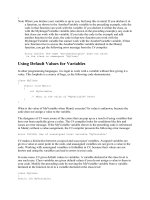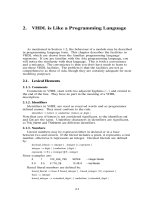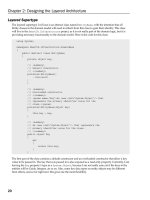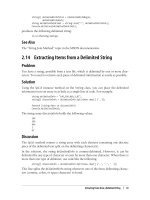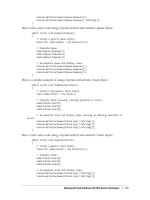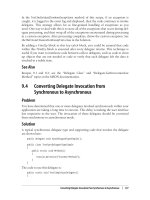C# 3.0 Cookbook phần 2 pptx
Bạn đang xem bản rút gọn của tài liệu. Xem và tải ngay bản đầy đủ của tài liệu tại đây (300.92 KB, 88 trang )
string[] delimitedInfoTotal = {delimitedInfoBegin,
delimitedInfoEnd};
string delimitedInfoFinal = string.Join(":", delimitedInfoTotal);
Console.WriteLine(delimitedInfoFinal);
produces the following delimited string:
11,12:Checking,Savings
See Also
The “String.Join Method” topic in the MSDN documentation.
2.14 Extracting Items from a Delimited String
Problem
You have a string, possibly from a text file, which is delimited by one or more characters. You need to retrieve each piece of delimited information as easily as possible.
Solution
Using the Split instance method on the String class, you can place the delimited
information into an array in as little as a single line of code. For example:
string delimitedInfo = "100,200,400,3,67";
string[] discreteInfo = delimitedInfo.Split(new char[] {','});
foreach (string Data in discreteInfo)
Console.WriteLine(Data);
The string array discreteInfo holds the following values:
100
200
400
3
67
Discussion
The Split method returns a string array with each element containing one discrete
piece of the delimited text split on the delimiting character(s).
In the solution, the string delimitedInfo is comma-delimited. However, it can be
delimited by any type of character or even by more than one character. When there is
more than one type of delimiter, use code like the following:
string[] discreteInfo = delimitedInfo.Split(new char[] {',', ':', ' '});
This line splits the delimitedInfo string whenever one of the three delimiting characters (comma, colon, or space character) is found.
Extracting Items from a Delimited String
|
63
The Split method is case-sensitive. To split a string on the letter a in a caseinsensitive manner, use code like the following:
string[] discreteInfo = delimitedInfo.Split(new char[] {'a', 'A'});
Now, anytime the letter a is encountered, no matter what its case, the Split method
views that character as a delimiter.
See Also
The “String.Join Method” topic in the MSDN documentation.
2.15 Iterating over Each Character in a String
Problem
You need to iterate over each character in a string efficiently in order to examine or
process each character.
Solution
C# provides two methods for iterating strings. The first is the foreach loop, which
can be used as follows:
string testStr = "abc123";
foreach (char c in testStr)
{
Console.WriteLine(c.ToString( ));
}
This method is quick and easy. Unfortunately, it is somewhat less flexible than the
second method, which uses the for loop instead of a foreach loop to iterate over the
string. For example:
string testStr = "abc123";
for (int counter = 0; counter < testStr.Length; counter++)
{
Console.WriteLine(testStr[counter]);
}
Discussion
The foreach loop is simpler and thus less error-prone, but it lacks flexibility. In
contrast, the for loop is slightly more complex, but it makes up for that in flexibility.
The for loop method uses the indexer of the string variable testStr to get the
character located at the position indicated by the counter loop index. Care must be
taken not to run over the bounds of the string array when using this type of looping
mechanism.
64 |
Chapter 2: Strings and Characters
A for loop is flexible enough to change how looping over characters in a string is performed. For example, the loop can be quickly modified to start and end at a specific
point in the string by simply changing the initializer and conditional expressions
of the for loop. Characters can be skipped by changing the iterator expression to
increment the counter variable by more than one. The string can also be iterated in
reverse order by changing the for loop expressions, as shown:
for (int counter = testStr.Length - 1; counter >= 0; counter--)
{
Console.WriteLine(testStr[counter].ToString( ));
}
The compiler optimizes the use of a foreach loop iterating through a
vector array—one that starts at zero and has only one dimension.
Converting a foreach loop to another type of loop, such as a for loop,
may not produce any noticeable increases in performance.
It should be noted that each of these methods was compiled using the /optimize
compiler option. Use of the /optimize flag will typically make the size of the compiled code smaller, not faster. The smaller the code, the faster it can load from disk
and the faster that it can be jitted.
2.16 Pruning Characters from the Head and/or Tail of
a String
Problem
You have a string with a specific set of characters, such as spaces, tabs, escaped single/double quotes, any type of punctuation character(s), or some other character(s),
at the beginning and/or end of a string. You want a simple way to remove these
characters.
Solution
Use the Trim, TrimEnd, or TrimStart instance methods of the String class:
string foo = "--TEST--";
Console.WriteLine(foo.Trim(new char[] {'-'}));
// Displays "TEST"
foo = ",-TEST-,-";
Console.WriteLine(foo.Trim(new char[] {'-',','}));
// Displays "TEST"
foo = "--TEST--";
Console.WriteLine(foo.TrimStart(new char[] {'-'}));
// Displays "TEST--"
foo = ",-TEST-,-";
Console.WriteLine(foo.TrimStart(new char[] {'-',','}));
// Displays "TEST-,-"
Pruning Characters from the Head and/or Tail of a String
|
65
foo = "--TEST--";
Console.WriteLine(foo.TrimEnd(new char[] {'-'}));
// Displays "--TEST"
foo = ",-TEST-,-";
Console.WriteLine(foo.TrimEnd(new char[] {'-',','}));
//Displays ",-TEST"
Discussion
The Trim method is most often used to eliminate whitespace at the beginning and
end of a string. In fact, if you call Trim without any parameters on a string variable,
this is exactly what happens. The Trim method is overloaded to allow you to remove
other types of characters from the beginning and end of a string. You can pass in a
char[] containing all the characters that you want removed from the beginning and
end of a string. Note that if the characters contained in this char[] are located somewhere in the middle of the string, they are not removed.
The TrimStart and TrimEnd methods remove characters at the beginning and end of a
string, respectively. These two methods are not overloaded, unlike the Trim method.
Rather, these two methods accept only a char[]. If you pass a null into either one of
these methods, only whitespace is removed from the beginning or the end of a string.
See Also
The “String.Trim Method,” “String.TrimStart Method,” and “String.TrimEnd
Method” topics in the MSDN documentation.
2.17 Testing a String for Null or Empty
Problem
You need a quick and easy way to check if a string is either null or of zero length.
Solution
Use the static IsNullOrEmpty method of the String class:
bool stringTestResult = String.IsNullOrEmpty(testString);
Discussion
The IsNullOrEmpty method is a very convenient method in that it allows you to test a
string for null or zero length with a single method call. This method returns true if
the string passed in to it is equal to one of the following:
• Null
• String.Empty
Otherwise, this method returns false.
66 |
Chapter 2: Strings and Characters
See Also
The “String.IsNullOrEmpty Method” topic in the MSDN documentation.
2.18 Appending a Line
Problem
You need to append a line, including a line terminator, to the current string.
Solution
Use the AppendLine method of the StringBuilder class:
StringBuilder sb = new StringBuilder("First line of string");
// Terminate the first line.
sb.AppendLine( );
// Add a second line.
sb.AppendLine("Second line of string");
This code will display the following:
First line of string
Second line of string
Discussion
The AppendLine method accepts a string and returns a reference to the same instance
of the StringBuilder object on which this method was called. The string that is
passed in to this method has a newline character or characters automatically
appended on to the end of this string. The newline character(s) is dependent on the
type of platform you are running. For example, Windows uses the \r\n carriage
return and line-feed characters to represent a newline; on a Unix system, the newline
consists of only the line-feed character \n. You do not need to worry about this, as
the AppendLine method knows which newline character(s) to apply.
If you simply want to add several blank lines to your string, you can call AppendLine
with no parameters. This effectively adds only a newline character to the current
string in the StringBuilder object on which it was called. Calling this method with
no parameter can also be used to add a newline character(s) to the current line, if the
current line has no newline character(s). For example, the code in the Solution added
a string with no newline character(s) to the instantiated StringBuilder object sb. You
can then call sb.AppendLine( ) to force a newline character to be appended to this
text.
See Also
The “StringBuilder.AppendLine Method” topic in the MSDN documentation.
Appending a Line
|
67
Chapter 3 3
CHAPTER
Classes and Structures
3.0
3
Introduction
Structures, like any other value type, implicitly inherit from System.ValueType. At
first glance, a structure is similar to a class, but it is actually very different. Knowing
when to use a structure over a class will help tremendously when designing an application. Using a structure incorrectly can result in inefficient and hard-to-modify
code.
Structures have two performance advantages over reference types. First, if a structure is allocated on the stack (i.e., it is not contained within a reference type), access
to the structure and its data is somewhat faster than access to a reference type on the
heap. Reference-type objects must follow their reference onto the heap in order to
get at their data. However, this performance advantage pales in comparison to the
second performance advantage of structures; namely, that cleaning up the memory
allocated to a structure on the stack requires a simple change of the address to which
the stack pointer points, which is done at the return of a method call. This call is
extremely fast compared to allowing the garbage collector to automatically clean up
reference types for you in the managed heap; however, the cost of the garbage collector is deferred so that it’s not immediately noticeable.
The performance of structures falls short in comparison to that of classes when they
are passed by value to other methods. Because they reside on the stack, a structure
and its data have to be copied to a new local variable (the method’s parameter that is
used to receive the structure) when it is passed by value to a method. This copying
takes more time than passing a method a single reference to an object—unless the
structure is the same size as or smaller than the machine’s pointer size; thus, a structure with a size of 32 bits is just as cheap to pass as a reference (which happens to be
the size of a pointer) on a 32-bit machine. Keep this in mind when choosing between
a class and a structure. While creating, accessing, and destroying a class’s object may
take longer, it also might not balance the performance hit when a structure is passed
68
by value a large number of times to one or more methods. Keeping the size of the
structure small minimizes the performance hit of passing it around by value.
Concerning the object-oriented capabilities of classes and structures, classes have far
more flexibility. A structure cannot contain a user-defined default constructor, since
the C# compiler automatically provides a default constructor that initializes all the
fields in the structure to their default values. This is also why no field initializers can
be added to a structure. If you need to override the default field values, a structure
might not be the way to go. However, a parameterized constructor that initializes the
structure’s fields to any value that is necessary can be created.
Structures, like classes, can implement interfaces, but unlike classes, structures cannot inherit from a class or a structure. This limitation precludes creating structure
hierarchies, as you can do with classes. Polymorphism, as implemented through an
abstract base class, is also prohibited when using a structure, since a structure cannot inherit from another class with the exception of boxing to Object, ValueType, or
Enum.
Use a class if:
• Its identity is important. Structures get copied implicitly when being passed by
value into a method.
• It will have a large memory footprint.
• Its fields need initializers.
• You need to inherit from a base class.
• You need polymorphic behavior. That is, you need to implement an abstract
base class from which you will create several similar classes that inherit from this
abstract base class. (Note that polymorphism can be implemented via interfaces
as well, but it is usually not a good idea to place an interface on a value type,
since a boxing operation will occur if the structure is converted to the interface
type.) For more on polymorphism through interfaces, see Recipe 3.15.
Use a structure if:
• It will act like a primitive type (int, long, byte, etc.).
• It must have a small memory footprint.
• You are calling a P/Invoke method that requires a structure to be passed in by
value. Platform Invoke, or P/Invoke for short, allows managed code to call out to
an unmanaged method exposed from within a DLL. Many times, an unmanaged
DLL method requires a structure to be passed in to it; using a structure is an efficient method of doing this and is the only way if the structure is being passed by
value.
• You need to avoid the overhead of garbage collection.
• Its fields need to be initialized only to their default values. This value would be
zero for numeric types, false for Boolean types, and null for reference types.
Introduction
|
69
• You do not need to inherit from a base class (other than ValueType, from which
all structs inherit).
• You do not need polymorphic behavior.
Structures can also cause degradation in performance when they are passed to methods that require an object, such as any of the nongeneric collection types in the
Framework Class Library (FCL). Passing a structure (or any simple type, for that
matter) into a method requiring an object causes the structure to be boxed. Boxing is
wrapping a value type in an object. This operation is time-consuming and may
degrade performance.
3.1
Creating Union-Type Structures
Problem
You need to create a data type that behaves like a union type in C++. A union type is
useful mainly in interop scenarios in which the unmanaged code accepts and/or
returns a union type; we suggest that you do not use it in other situations.
Solution
Use a structure and mark it with the StructLayout attribute (specifying the
LayoutKind.Explicit layout kind in the constructor). In addition, mark each field in
the structure with the FieldOffset attribute. The following structure defines a union
in which a single signed numeric value can be stored:
using System.Runtime.InteropServices;
[StructLayoutAttribute(LayoutKind.Explicit)]
struct SignedNumber
{
[FieldOffsetAttribute(0)]
public sbyte Num1;
[FieldOffsetAttribute(0)]
public short Num2;
[FieldOffsetAttribute(0)]
public int Num3;
[FieldOffsetAttribute(0)]
public long Num4;
[FieldOffsetAttribute(0)]
public float Num5;
[FieldOffsetAttribute(0)]
public double Num6;
[FieldOffsetAttribute(0)]
public decimal Num7;
}
The next structure is similar to the SignedNumber structure, except that it can contain
a String type in addition to the signed numeric value:
70 |
Chapter 3: Classes and Structures
[StructLayoutAttribute(LayoutKind.Explicit)]
struct SignedNumberWithText
{
[FieldOffsetAttribute(0)]
public sbyte Num1;
[FieldOffsetAttribute(0)]
public short Num2;
[FieldOffsetAttribute(0)]
public int Num3;
[FieldOffsetAttribute(0)]
public long Num4;
[FieldOffsetAttribute(0)]
public float Num5;
[FieldOffsetAttribute(0)]
public double Num6;
[FieldOffsetAttribute(0)]
public decimal Num7;
[FieldOffsetAttribute(16)]
public string Text1;
}
Discussion
Unions are structures usually found in C++ code; however, there is a way to duplicate that type of structure using a C# structure data type. A union is a structure that
accepts more than one type at a specific location in memory for that structure. For
example, the SignedNumber structure is a union-type structure built using a C# structure. This structure accepts any type of signed numeric type (sbyte, int, long, etc.),
but it accepts this numeric type at only one location, or offset, within the structure.
Since StructLayoutAttribute can be applied to both structures and
classes, a class can also be used when creating a union data type.
Notice the FieldOffsetAttribute has the value zero passed to its constructor. This
denotes that this field will be offset by zero bytes from the beginning of the structure. This attribute is used in tandem with the StructLayoutAttribute to manually
enforce where the fields in this structure will start (that is, the offset from the beginning of this structure in memory where each field will start). The
FieldOffsetAttribute can be used only with a StructLayoutAttribute set to
LayoutKind.Explicit. In addition, it cannot be used on static members within this
structure.
Unions can become problematic, since several types are essentially laid on top of one
another. The biggest problem is extracting the correct data type from a union structure. Consider what happens if you choose to store the long numeric value long.
MaxValue in the SignedNumber structure. Later, you might accidentally attempt to
Creating Union-Type Structures |
71
extract a byte data type value from this same structure. In doing so, you will get back
only the first byte of the long value.
Another problem is starting fields at the correct offset. The SignedNumberWithText
union overlays numerous signed numeric data types at the zeroth offset. The last
field in this structure is laid out at the 16th byte offset from the beginning of this
structure in memory. If you accidentally overlay the string field Text1 on top of any
of the other signed numeric data types, you will get an exception at runtime. The
basic rule is that you are allowed to overlay a value type on another value type, but
you cannot overlay a reference type over a value type. If the Text1 field is marked
with the following attribute:
[FieldOffsetAttribute(14)]
this exception is thrown at runtime (note that the compiler does not catch this
problem):
An unhandled exception of type 'System.TypeLoadException' occurred in
Chapter_Code.exe.
Additional information: Could not load type Chapter_Code.SignedNumberWithText
from
assembly 14 because it contains an object field at offset 14 that is incorrectly
aligned or overlapped by a non-object field.
It is imperative to get the offsets correct when using complex unions in C#.
See Also
The “StructLayoutAttribute Class” topic in the MSDN documentation.
3.2
Making a Type Sortable
Problem
You have a data type that will be stored as elements in a List<T> or a
SortedList<K,V>. You would like to use the List<T>.Sort method or the internal sorting mechanism of SortedList<K,V> to allow custom sorting of your data types in the
array. In addition, you may need to use this type in a SortedList collection.
Solution
Example 3-1 demonstrates how to implement the IComparable<T> interface. The
Square class shown in Example 3-1 implements this interface in such a way that the
List<T> and SortedList<K,V> collections can sort and search for these Square objects.
72 |
Chapter 3: Classes and Structures
Example 3-1. Making a type sortable by implementing IComparable<T>
public class Square : IComparable<Square>
{
public Square( ){}
public Square(int height, int width)
{
this.Height = height;
this.Width = width;
}
public int Height { get; set; }
public int Width { get; set; }
public int CompareTo(object obj)
{
Square square = obj as Square;
if (square != null)
return CompareTo(square);
throw
new ArgumentException("Both objects being compared must be of type Square.");
}
public override string ToString( )
{
return ("Height:" + this.Height + "
}
Width:" + this.Width);
public override bool Equals(object obj)
{
if (obj == null)
return false;
Square square = obj as Square;
if(square != null)
return this.Height == square.Height;
return false;
}
public override int GetHashCode( )
{
return this.Height.GetHashCode( ) | this.Width.GetHashCode( );
}
public static bool operator ==(Square x, Square y)
{
return x.Equals(y);
}
public static bool operator !=(Square x, Square y)
{
return !(x == y);
}
Making a Type Sortable
|
73
Example 3-1. Making a type sortable by implementing IComparable<T> (continued)
public static bool operator <(Square x, Square y)
{
return (x.CompareTo(y) < 0);
}
public static bool operator >(Square x, Square y)
{
return (x.CompareTo(y) > 0);
}
#region IComparable<Square> Members
public int CompareTo(Square other)
{
long area1 = this.Height * this.Width;
long area2 = other.Height * other.Width;
if (area1 == area2)
return 0;
else if (area1 > area2)
return 1;
else if (area1 < area2)
return -1;
else
return -1;
}
#endregion
}
Discussion
By implementing the IComparable<T> interface on your class (or structure), you can
take advantage of the sorting routines of the List<T>, and SortedList<K,V> classes.
The algorithms for sorting are built into these classes; all you have to do is tell them
how to sort your classes via the code you implement in the IComparable<T>.CompareTo
method.
When a list of Square objects is sorted by calling the List<Square>.Sort method, the
list is sorted using the IComparable<Square> interface of the Square objects. The Add
method of the SortedList<K,V> class uses this interface to sort the objects as they are
being added to the SortedList<K,V>.
IComparer<T> is designed to solve the problem of allowing objects to be sorted based
on different criteria in different contexts. This interface also allows you to sort types
that you did not write. If you also wanted to sort the Square objects by height, you
could create a new class called CompareHeight, shown in Example 3-2, which would
also implement the IComparer<Square> interface.
74 |
Chapter 3: Classes and Structures
Example 3-2. Making a type sortable by implementing IComparer
public class CompareHeight : IComparer<Square>
{
public int Compare(object firstSquare, object secondSquare)
{
Square square1 = firstSquare as Square;
Square square2 = secondSquare as Square;
if (square1 == null || square2 == null)
throw (new ArgumentException("Both parameters must be of type Square."));
else
return Compare(firstSquare,secondSquare);
}
#region IComparer<Square> Members
public int Compare(Square x, Square y)
{
if (x.Height == y.Height)
return 0;
else if (x.Height > y.Height)
return 1;
else if (x.Height < y.Height)
return -1;
else
return -1;
}
#endregion
}
This class is then passed in to the IComparer parameter of the Sort routine. Now you
can specify different ways to sort your Square objects. The comparison method
implemented in the comparer must be consistent and apply a total ordering so that
when the comparison function declares equality for two items, it is absolutely true
and not a result of one item not being greater than another or one item not being less
than another.
For best performance, keep the CompareTo method short and efficient,
because it will be called multiple times by the Sort methods. For
example, in sorting an array with four items, the Compare method is
called 10 times.
The TestSort method shown in Example 3-3 demonstrates how to use the Square
and CompareHeight classes with the List<Square> and SortedList<int,Square>
instances.
Making a Type Sortable
|
75
Example 3-3. TestSort method
public static void TestSort( )
{
List<Square> listOfSquares = new List<Square>( ){
new Square(1,3),
new Square(4,3),
new Square(2,1),
new Square(6,1)};
// Test a List<String>
Console.WriteLine("List<String>");
Console.WriteLine("Original list");
foreach (Square square in listOfSquares)
{
Console.WriteLine(square.ToString( ));
}
Console.WriteLine( );
IComparer<Square> heightCompare = new CompareHeight( );
listOfSquares.Sort(heightCompare);
Console.WriteLine("Sorted list using IComparer<Square>=heightCompare");
foreach (Square square in listOfSquares)
{
Console.WriteLine(square.ToString( ));
}
Console.WriteLine( );
Console.WriteLine("Sorted list using IComparable<Square>");
listOfSquares.Sort( );
foreach (Square square in listOfSquares)
{
Console.WriteLine(square.ToString( ));
}
// Test a SORTEDLIST
var sortedListOfSquares =
{
{
{
{
new SortedList<int,Square>( ){
0, new Square(1,3)},
2, new Square(3,3)},
1, new Square(2,1)},
3, new Square(6,1)}};
Console.WriteLine( );
Console.WriteLine( );
Console.WriteLine("SortedList<Square>");
foreach (KeyValuePair<int,Square> kvp in sortedListOfSquares)
{
Console.WriteLine(kvp.Key + " : " + kvp.Value);
}
}
76 |
Chapter 3: Classes and Structures
This code displays the following output:
List<String>
Original list
Height:1 Width:3
Height:4 Width:3
Height:2 Width:1
Height:6 Width:1
Sorted list using IComparer<Square>=heightCompare
Height:1 Width:3
Height:2 Width:1
Height:4 Width:3
Height:6 Width:1
Sorted list using IComparable<Square>
Height:2 Width:1
Height:1 Width:3
Height:6 Width:1
Height:4 Width:3
SortedList<Square>
0 : Height:1 Width:3
1 : Height:2 Width:1
2 : Height:3 Width:3
3 : Height:6 Width:1
See Also
Recipe 3.3, and the “IComparable<T> Interface” topic in the MSDN documentation.
3.3
Making a Type Searchable
Problem
You have a data type that will be stored as elements in a List<T>. You would like to
use the BinarySearch method to allow for custom searching of your data types in the
list.
Solution
Use the IComparable<T> and IComparer<T> interfaces. The Square class, from Recipe 3.1,
implements the IComparable<T> interface in such a way that the List<T> and
SortedList<K,V> collections can sort and search an array or collection of Square objects.
Making a Type Searchable |
77
Discussion
By implementing the IComparable<T> interface on your class (or structure), you can
take advantage of the search routines of the List<T> and SortedList<K,V> classes.
The algorithms for searching are built into these classes; all you have to do is tell
them how to search your classes via the code you implement in the IComparable<T>.
CompareTo method.
To implement the CompareTo method, see Recipe 3.2.
The List<T> class provides a BinarySearch method to perform a search on the elements in that list. The elements are compared against an object passed to the
BinarySearch method in the object parameter. The SortedList class does not have a
BinarySearch method; instead, it has the ContainsKey method, which performs a
binary search on the key contained in the list. The ContainsValue method of the
SortedList class performs a linear search when searching for values. This linear
search uses the Equals method of the elements in the SortedList collection to do its
work. The Compare and CompareTo methods do not have any effect on the operation of
the linear search performed in the SortedList class, but they do have an effect on
binary searches.
To perform an accurate search using the BinarySearch methods of the
List<T> class, you must first sort the List<T> using its Sort method. In
addition, if you pass an IComparer<T> interface to the BinarySearch
method, you must also pass the same interface to the Sort method.
Otherwise, the BinarySearch method might not be able to find the
object you are looking for.
The TestSort method shown in Example 3-4 demonstrates how to use the Square
and CompareHeight classes with the List<Square> and SortedList<int,Square> collection instances.
Example 3-4. Making a type searchable
public static void TestSearch( )
{
List<Square> listOfSquares = new List<Square> {new Square(1,3),
new Square(4,3),
new Square(2,1),
new Square(6,1)};
IComparer<Square> heightCompare = new CompareHeight( );
// Test a List<Square>
Console.WriteLine("List<Square>");
Console.WriteLine("Original list");
foreach (Square square in listOfSquares)
{
Console.WriteLine(square.ToString( ));
}
78 |
Chapter 3: Classes and Structures
Example 3-4. Making a type searchable (continued)
Console.WriteLine( );
Console.WriteLine("Sorted list using IComparer<Square>=heightCompare");
listOfSquares.Sort(heightCompare);
foreach (Square square in listOfSquares)
{
Console.WriteLine(square.ToString( ));
}
Console.WriteLine( );
Console.WriteLine("Search using IComparer<Square>=heightCompare");
int found = listOfSquares.BinarySearch(new Square(1,3), heightCompare);
Console.WriteLine("Found (1,3): " + found);
Console.WriteLine( );
Console.WriteLine("Sorted list using IComparable<Square>");
listOfSquares.Sort( );
foreach (Square square in listOfSquares)
{
Console.WriteLine(square.ToString( ));
}
Console.WriteLine("Search using IComparable<Square>");
found = listOfSquares.BinarySearch(new Square(6,1)); // Use IComparable
Console.WriteLine("Found (6,1): " + found);
// Test a SortedList<Square>
var sortedListOfSquares = new SortedList<int,Square>( ){
{0, new Square(1,3)},
{2, new Square(4,3)},
{1, new Square(2,1)},
{4, new Square(6,1)}};
Console.WriteLine( );
Console.WriteLine( );
Console.WriteLine("SortedList<Square>");
foreach (KeyValuePair<int,Square> kvp in sortedListOfSquares)
{
Console.WriteLine(kvp.Key + " : " + kvp.Value);
}
Console.WriteLine( );
bool foundItem = sortedListOfSquares.ContainsKey(2);
Console.WriteLine("sortedListOfSquares.ContainsKey(2): " + foundItem);
// Does not use IComparer or IComparable
// -- uses a linear search along with the Equals method
//
which has not been overloaded
Square value = new Square(6,1);
foundItem = sortedListOfSquares.ContainsValue(value);
Console.WriteLine("sortedListOfSquares.ContainsValue(new Square(6,1)): " + foundItem);
}
Making a Type Searchable |
79
This code displays the following:
List<Square>
Original list
Height:1 Width:3
Height:4 Width:3
Height:2 Width:1
Height:6 Width:1
Sorted list using IComparer<Square>=heightCompare
Height:1 Width:3
Height:2 Width:1
Height:4 Width:3
Height:6 Width:1
Search using IComparer<Square>=heightCompare
Found (1,3): 0
Sorted list using IComparable<Square>
Height:2 Width:1
Height:1 Width:3
Height:6 Width:1
Height:4 Width:3
Search using IComparable<Square>
Found (6,1): 2
SortedList<Square>
0 : Height:1 Width:3
1 : Height:2 Width:1
2 : Height:4 Width:3
4 : Height:6 Width:1
sortedListOfSquares.ContainsKey(2): True
sortedListOfSquares.ContainsValue(new Square(6,1)): True
See Also
Recipe 3.2, and the “IComparable<T> Interface” and “IComparer<T> Interface”
topics in the MSDN documentation.
3.4
Indirectly Overloading the +=, -=, /=, and *=
Operators
Problem
You need to control the handling of the +=, -=, /=, and *= operators within your data
type; unfortunately, these operators cannot be directly overloaded.
80 |
Chapter 3: Classes and Structures
Solution
Overload these operators indirectly by overloading the +, -, /, and * operators, as
demonstrated in Example 3-5.
Example 3-5. Overloading the +, -, /, and * operators
public class Foo
{
// Other class members...
// Overloaded binary operators
public static Foo operator +(Foo f1, Foo f2)
{
Foo result = new Foo( );
// Add f1 and f2 here...
// place result of the addition into the result variable.
return result;
}
public static Foo operator +(int constant, Foo f1)
{
Foo result = new Foo( );
// Add the constant integer and f1 here...
// place result of the addition into the result variable.
return result;
}
public static Foo operator +(Foo f1, int constant)
{
Foo result = new Foo( );
// Add the constant integer and f1 here...
// place result of the addition into the result variable.
return result;
}
// The pattern above is repeated for the -, *, and . operators as well...
}
Discussion
While it is illegal to overload the +=, -=, /=, and *= operators directly, you can overload them indirectly by overloading the +, -, /, and * operators. The +=, -=, /=, and
*= operators use the overloaded +, -, /, and * operators for their calculations.
The four operators +, -, /, and * are overloaded by the methods in the Solution section of this recipe. You might notice that each operator is overloaded three times.
This is intentional, since a user of your object may attempt to add, subtract, multiply, or divide it by an integer value. The unknown here is: which position will the
integer constant be in? Will it be in the first parameter or the second? The following
code snippet shows how this might look for multiplication:
Foo x = new Foo( );
Foo y = new Foo( );
y *= 100;
// Uses: operator *(Foo f1, int multiplier)
Indirectly Overloading the +=, -=, /=, and *= Operators
|
81
y = 100 * x;
y *= x;
// Uses: operator *(int multiplier, Foo f1)
// Uses: operator *(Foo f1, Foo f2)
The same holds true for the other overloaded operators.
If these operators were being implemented in a class, you would first check whether
any were set to null. The following code for the overloaded addition operator has
been modified to do this:
public static Foo operator +(Foo f1, Foo f2)
{
if (f1 == null)
{
throw (new ArgumentNullException("f1"));
}
else if (f2 == null)
{
throw (new ArgumentNullException("f2"));
}
else
{
Foo result = new Foo( );
// Add f1 and f2 here...
// place result of the addition into the result variable.
return (result);
}
}
See Also
The “Operator Overloading Usage Guidelines,” “Overloadable Operators,” and
“Operator Overloading Tutorial” topics in the MSDN documentation.
3.5
Indirectly Overloading the &&, ||, and ?:
Operators
Problem
You need to control the handling of the &&, ||, and ?: operators within your data
type; unfortunately, these operators cannot be directly overloaded.
Solution
Overload these operators indirectly by overloading the &, |, true, and false operators, as shown in Example 3-6.
Example 3-6. Overloading &, |, true, and false
public class ObjState
{
public ObjState(int state)
82 |
Chapter 3: Classes and Structures
Example 3-6. Overloading &, |, true, and false (continued)
{
this.State = state;
}
public int State {get; set;}
public ObjState RetObj(int state)
{
return (new ObjState(state));
}
public static ObjState operator &(ObjState obj1, ObjState obj2)
{
if (obj1 == null || obj2 == null)
throw (new ArgumentNullException("Neither object may be null."));
if (obj1.State >= 0 && obj2.State >= 0)
return (new ObjState(1));
else
return (new ObjState(-1));
}
public static ObjState operator |(ObjState obj1, ObjState obj2)
{
if (obj1.State < 0 && obj2.State < 0)
return (new ObjState(-1));
else
return (new ObjState(1));
}
public static bool operator true(ObjState obj)
{
if (obj.State >= 0)
return true;
else
return false;
}
public static bool operator false(ObjState obj)
{
if (obj.State >= 0)
return true;
else
return false;
}
public override string ToString( )
{
return State.ToString( );
}
}
Indirectly Overloading the &&, ||, and ?: Operators
|
83
This technique gives you complete control over the operations of the &&, ||, and ?:
operators.
Alternatively, you can simply add an implicit conversion to bool:
public class ObjState
{
public ObjState(int state)
{
this.State = state;
}
public int State {get; set;}
public static implicit operator bool(ObjState obj)
{
if (obj.State == 0)
throw new InvalidOperationException( );
return (obj.State > 0);
}
}
This technique implements strict Boolean logic; the first technique (overriding the
&&, ||, and ?: operators) gives you more freedom to stray from implementing strict
Boolean logic.
Discussion
While you cannot overload the &&, ||, and ?: operators directly, you can overload
them indirectly by overloading the &, |, true, and false operators. The &&, ||, and ?:
operators then use the overloaded &, |, true, and false operators for their calculations.
The && operator indirectly uses the false and & operators to perform a short-circuiting AND operation. Initially, the false operator is invoked to determine whether the
first object is equal to false. If so, the right side of the expression is not evaluated,
and the left side is returned. If the false operator returns a true, the & operator is
invoked next to perform the ANDing operation on the two objects. This initial test
using the false operator enables the operator to short-circuit the operation.
The || operator works the same as the && operator, except that the initial test is done
using the true operator rather than the false operator.
The ?: operator requires that its first argument be an expression of a type which can
either be implicitly converted to bool or which implements operator true. Note that
this, in turn, requires the overloading of the false operator for symmetry. The ?:
operator takes a condition as input and evaluates either converts it to bool or calls
operator true. This operator can be defined as follows:
condition ? true-expression : false-expression
84 |
Chapter 3: Classes and Structures
The ?: operator invokes the true operator to determine which expression of this
operator should be evaluated. Note that if an implicit conversion to bool exists, it
will be used in preference to the true operator.
When implementing these operators, you should first check to determine whether
any parameters in the overloaded operator methods were set to null. The code for
the overloaded & operator has been modified to do this:
public static ObjState operator &(ObjState obj1, ObjState obj2)
{
if (obj1 == null || obj2 == null)
{
throw (new ArgumentNullException("Neither object may be null."));
}
if (obj1.state >= 0 && obj2.state >= 0)
return (new ObjState(1));
else
return (new ObjState(-1));
}
See Also
The “Operator Overloading Usage Guidelines,” “Overloadable Operators,” and
“Operator Overloading Tutorial” topics in the MSDN documentation.
3.6
Making Error-Free Expressions
Problem
A complex expression in your code is returning incorrect results. For example, if you
wanted to find the average area given to two circles, you might write the following
expression:
double radius1 = 2;
double radius2 = 4;
double aveArea = .5 * Math.PI * Math.Pow(radius1, 2) + Math.PI *
Math.Pow(radius2, 2);
However, the result is always incorrect.
Complex mathematical and Boolean equations in your code can easily become the
source of bugs. You need to write bug-free equations, while at the same time making
them easier to read.
Solution
The solution is quite simple: use parentheses to explicitly define the order of operations that will take place in your equation. If the expression is difficult to get right
even when using parentheses, then it is probably too complex; consider breaking
Making Error-Free Expressions
|
85
each subpart or the expression into separate methods for each part of the expression
and then combine the methods to get the final result.
To fix the expression presented in the Problem section, rewrite it as follows:
double radius1 = 2;
double radius2 = 4;
double aveArea = .5 * (Math.PI * Math.Pow(radius1, 2) + Math.PI *
Math.Pow(radius2, 2));
Notice the addition of the parentheses; these parentheses cause the area of the two circles to be calculated and added together first. Then the total area is multiplied by .5.
This is the behavior you are looking for. An additional benefit is that the expression
can become easier to read as the parentheses provide clear distinction of what part of
the expression is to be evaluated first. This technique works equally well with Boolean equations.
Discussion
Parentheses are key to writing maintainable and bug-free equations. Not only is your
intention clearly spelled out, but you also override any operator precedence rules
that you might not have taken into account. In fact, the only way to override operator precedence is to use parentheses. Consider the following equation:
int x = 1 * 2 - -50 / 4 + 220 << 1;
Console.WriteLine("x = " + x);
The value 468 is displayed for this equation.
This is the same equation written with parentheses:
int y = ((1 * 2) - ((-50) / 4) + 220) << 1;
Console.WriteLine("y = " + y);
The same value (468) is also displayed for this equation. Notice how much easier it is
to read and understand how this equation works when parentheses are used. However, it is possible to get carried away with the use of parentheses in an equation:
int z = ((((1 * 2) - ((-50) / 4)) + 220) << (1));
Console.WriteLine("z = " + z);
This equation also evaluates to 468, but due to the overuse of parentheses, you can
get lost determining where one set of parentheses begins and where it ends. You
should try to balance your placement of parentheses in strategic locations to prevent
oversaturating your equation with parentheses.
Another place where you can get into trouble with operator precedence is when
using a ternary operator (?:), defined as follows:
boolean condition ? true-expression : false-expression
Each type of expression used by this operator is defined as follows:
86 |
Chapter 3: Classes and Structures
boolean-expression
This expression must evaluate to a Boolean value or to a value with a type that
has an implicit conversion to bool or one that has a true operator. Depending on
the outcome of this expression, either the true-case-expression or the falsecase-expression will be executed.
true-case-expression
This expression is evaluated when the boolean-expression evaluates to true.
false-case-expression
This expression is evaluated when the boolean-expression evaluates to false.
Either the true-case-expression or the false-case-expression will be evaluated;
never both.
The ternary operator is sometimes able to compact several lines of an if-else statement into a single expression that can fit easily on a single line. This ternary statement is also usable inline with a statement or another expression. The following code
example shows the use of the ternary operator inline with an expression:
byte x = (byte)(8 + ((foo == 1) ? 4 : 2));
By examining the order of operator precedence, you can see that the == operator has
the highest precedence and the compiler combines the results of this subexpression
to make it be evaluated first, and then the ternary operator. Depending on the result
of the Boolean expression foo == 1, the ternary operator will produce either the
value 4 or 2. This value is then added to 8 and assigned to the variable x.
Expression evaluation in C# is done from left to right in all cases.
Operator precedence affects how the final result is achieved, but the
expression is always evaluated left to right.
This operator is considered to have right-associative properties, similar to the assignment operators. Because of this, you can get into trouble using ternary expressions as
expressions within other ternary expressions. Consider the following code:
// foo currently equals 1
// Assume that all methods will always return a Boolean true, except for Method3,
// which always returns a Boolean false.
Console.WriteLine(Method1() ? Method2() : Method3() ? Method4( ) : Method5( ));
Which methods will be called? If you started determining precedence of the components of the expression, your expression would essentially look like the following:
Console.WriteLine((Method1() ? Method2( ) : Method3( )) ? Method4( ) : Method5( ));
Notice the extra highlighted parentheses added to clarify how the precedence will be
determined in this manner. The answer that the methods Method1, Method2, and
Method4 will be called is wrong. The correct answer is that only Method1 and Method2
Making Error-Free Expressions
|
87


